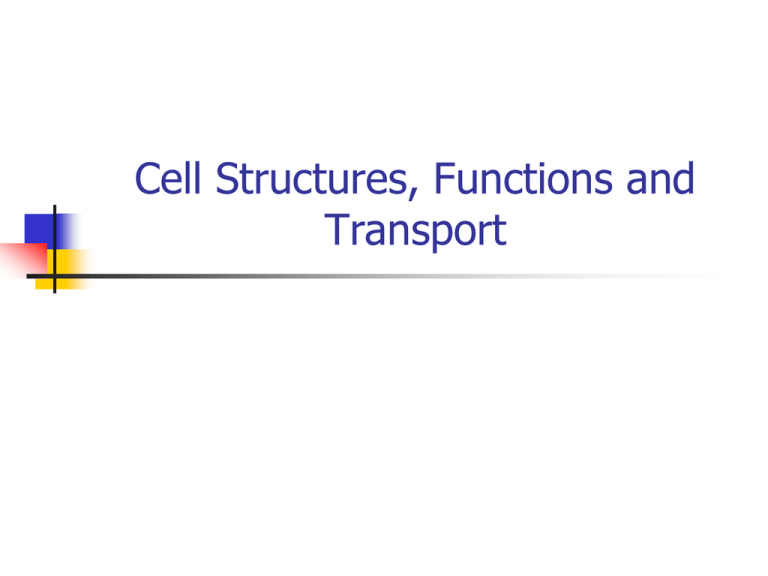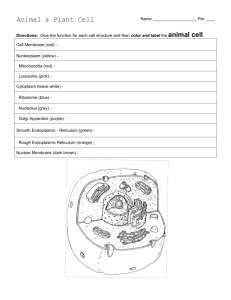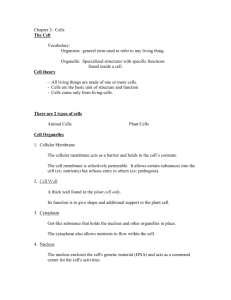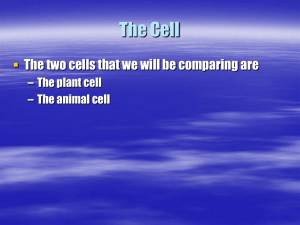Animal Cell - TeacherWeb
advertisement

Cell Structures, Functions and Transport Types of Cells Prokaryotic cells Eukaryotic cells Prokaryotic cells Simplest cells No membranes around their nuclear material (DNA and RNA, genetic material) Prokaryotes include bacteria and some pond scum Eukaryotic cells Eukaryotic cells have membranes around their nuclear material Membrane bound organelles Eukaryotes include protists, fungi, plants, and animals (almost all organisms) Figure 7-5 Plant and Animal Cells Section 7-2 Go to Section: Animal Cell Figure 7-5 Plant and Animal Cells Section 7-2 Animal Cell Cell Membrane Go to Section: Cell membrane Eukaryotic Cell Organelles and Function Cell Membrane 1. Nickname: “The Gatekeeper” Function: forms outer boundary of the cell allows only certain materials to move into and out of the cell Parts: made up of a double layer of fats with some proteins scattered throughout Figure 7-5 Plant and Animal Cells Section 7-2 Animal Cell Cytoplasm Cell Membrane Go to Section: Cell membrane Cytoplasm Eukaryotic Cell Organelles and Function Cytoplasm 2. Gel-like material inside the cell membrane and outside the nucleus Function: contains water, chemicals, and the various cell organelles Cytoplasm constantly moves or streams Figure 7-5 Plant and Animal Cells Animal Cell Section 7-2 Cytoplasm Nucleolus Nucleus Nuclear Membrane Go to Section: Cell Membrane Cell membrane Cytoplasm Nucleus Nucleolus Nuclear envelope/membrane Eukaryotic Cell Organelles and Function Nucleus 3. Nickname: “The Control Center” Function: holds the DNA Parts: 1. 2. Nucleolus: dark spot in the middle of the nucleus that helps make ribosomes Nuclear envelope/membrane: surrounds nucleus in eukaryotic cells, has pores to let material in and out of the nucleus Eukaryotic Cell Organelles and Function Nucleus 3. Parts: 3. Chromatin: Strands of genetic material found in the nucleus, made of protein and DNA Figure 7-5 Plant and Animal Cells Animal Cell Section 7-2 Cytoplasm Nucleolus Nucleus Nuclear Membrane Cell Membrane Mitochondria Cell membrane Cytoplasm Nucleus Nucleolus Nuclear envelope/membrane Mitochondria Eukaryotic Cell Organelles and Function Mitochondria 8. Nickname: “The Powerhouse” Function: Energy formation Breaks down food to make ATP ATP: is the major fuel for all cell activities that require energy Figure 7-5 Plant and Animal Cells Animal Cell Section 7-2 Cytoplasm Nucleolus Nucleus Nuclear membrane Go to Section: Ribosomes Ribosomes Cell Membrane Mitochondria Cell membrane Cytoplasm Nucleus Nucleolus Nuclear envelope/membrane Ribosomes Mitochondria Eukaryotic Cell Organelles and Function Ribosomes 4. Function: makes proteins Found in all cells, prokaryotic and eukaryotic Figure 7-5 Plant and Animal Cells Animal Cell Section 7-2 Cytoplasm Nucleolus Nucleus Nuclear Membrane Rough Endoplasmic Reticulum Go to Section: Ribosomes Ribosomes Cell Membrane Mitochondria Smooth Endoplasmic Reticulum Cell membrane Cytoplasm Nucleus Rough Endoplasmic Reticulum Nucleolus Smooth Endoplasmic Reticulum Nuclear envelope/membrane Ribosomes Mitochondria Eukaryotic Cell Organelles and Function Endoplasmic Reticulum (ER) 5. Nickname: “Roads” Function: The internal delivery system of the cell Endoplasmic Reticulum 2 Types: 1. Rough ER: 2. Rough appearance because it has ribosomes on its surface Function: helps make proteins, that’s why it has ribosomes Smooth ER: NO ribosomes Function: makes fats or lipids Figure 7-5 Plant and Animal Cells Animal Cell Section 7-2 Cytoplasm Nucleolus Nucleus Ribosomes Ribosomes Cell Membrane Nuclear membrane Rough Endoplasmic Reticulum Golgi Complex Go to Section: Smooth Endoplasmic Reticulum Cell membrane Cytoplasm Nucleus Rough Endoplasmic Reticulum Nucleolus Smooth Endoplasmic Reticulum Nuclear envelope/membrane Ribosomes Mitochondria Golgi Body Eukaryotic Cell Organelles and Function Golgi Complex (Golgi Body) 6. Nickname: The shippers Function: packages, modifies, and transports materials to different location inside/outside of the cell Appearance: stack of pancakes Structure: stack of membrane-covered sacs Figure 7-5 Plant and Animal Cells Animal Cell Section 7-2 Cytoplasm Nucleolus Nucleus Cell Membrane Nuclear Membrane Mitochondria Rough Endoplasmic Reticulum Golgi Body Go to Section: Ribosomes Ribosomes Smooth Endoplasmic Reticulum Cell membrane Lysosome Cytoplasm Nucleus Rough Endoplasmic Reticulum Nucleolus Smooth Endoplasmic Reticulum Nuclear envelope/membrane Ribosomes Mitochondria Golgi Body Eukaryotic Cell Organelles and Function Lysosomes: circular, but bigger than ribosomes 7. Nickname: “Clean-up Crews” Function: to break down food into particles the rest of the cell can use and to destroy old cells Cell membrane Lysosome Cytoplasm Nucleus Rough Endoplasmic Reticulum Nucleolus Smooth Endoplasmic Reticulum Nuclear envelope/membrane Vacuole Mitochondria Ribosomes Golgi Body Eukaryotic Cell Organelles and Function Vacuoles 9. Function: Help store things Vacuoles in animal cells are usually small sacs Animal Cell Cytoplasm Nucleolus Ribosomes Ribosomes Nucleus Cell Membrane Nuclear Membrane Mitochondria Rough Endoplasmic Reticulum Golgi Bodies Smooth Endoplasmic Reticulum Centrioles Cell membrane Lysosome Centriole (only 1 is shown) Cytoplasm Nucleus Rough Endoplasmic Reticulum Nucleolus Smooth Endoplasmic Reticulum Nuclear envelope/membrane Ribosomes Mitochondria Golgi Body Eukaryotic Cell Organelles and Function Centrioles 10. Function: Help with cell division Only found in animal cells Look like two small bundles of spaghetti arranged perpendicular to each other Now let’s talk about structures only found in PLANT Cells!! Figure 7-5 Plant and Animal Cells Section 7-2 Plant Cell Vacuole Cell Membrane Go to Section: Eukaryotic Cell Organelles and Function Vacuoles 11. Function: stores water This is what makes lettuce crisp When there is no water, the plant wilts Animal cells have vacuoles to provide temporary storage Vacuoles in animal cells are smaller than plant vacuoles Vacuole Figure 7-5 Plant and Animal Cells Plant Cell Section 7-2 Vacuole Chloroplasts Cell Membrane Go to Section: Vacuole Chloroplast Eukaryotic Cell Organelles and Function Chloroplasts 12. Function: traps energy from the sun to produce food for the plant cell Green in color because of chlorophyll, which is a green pigment Chloroplasts Figure 7-5 Plant and Animal Cells Plant Cell Section 7-2 Vacuole Chloroplasts Cell Membrane Cell Wall Go to Section: Cell wall Eukaryotic Cell Organelles and Function Cell Wall 13. Function: provides support and protection to the cell membrane Found outside the cell membrane in plant cells Plant Cell Cytoplasm Vacuole Smooth ER Ribosomes Chloroplasts Rough ER Cell Membrane Cell Wall Nuclear Membrane Nucleolus Golgi Bodies Nucleus Mitochondria Rough ER Cell wall Cell membrane Cytoplasm Lysosome Vacuole Nucleus Rough ER Nucleolus Smooth ER Nuclear envelope/membrane Chloroplast Mitochondria Ribosomes Golgi Bodies Comparing Plant and Animal Cells Plant Animal Comparing Plant and Animal Cells Plant Cell Wall Chloroplasts Large vacuole Animal Cell Membrane Cytoplasm Nucleus Nucleolus Nuclear membrane Mitochondria Centrioles Ribosomes Small vacuole Rough Endoplasmic Reticulum Smooth Endoplasmic Reticulum Golgi Bodies Lysosomes Vacuoles Cell Transport It’s a question of control. Who’s in control? Cells get nutrients, etc. from environment Release waste into same environment Moving along…or not! Selective permeability: property of a cell membrane which allows some materials to pass through while keeping others out. Diffusion Molecules move constantly Move from crowded conditions to less crowded conditions Particles diffuse in liquids and in gases Diffusion cont’d Equilibrium: molecules of a substance are spread evenly throughout a space Molecules continue to move during equilibrium Osmosis—Diffusion of H2O The diffusion of water through a cell membrane Most cells surrounded by water molecules and contain water molecules Osmosis Cont’d What happened to egg cells in lab? If cells aren’t surrounded by pretty pure water, they’ll lose the water. No water molecules in corn syrup around eggs—so …. Water tended to move out of the cells and dilute the corn syrup Cells became shriveled and yolks became firm Place eggs in pure water and the process is reversed The eggs swell up and the yolks slosh around inside Moving on… Particle movement across cell membrane by diffusion is called passive transport because… Cell doesn’t use energy to move the materials Active transport: energy required to move large molecules through cell membrane Need help of transport proteins Active transport is required to move substances from where there are small amounts to where there are large amounts Cell membrane Cell membrane is composed of a double layer (bilayer) of phospholipids with protein molecules scattered throughout Phospholipids make a bilayer with polar heads facing out and hydrophobic tails facing in Cell membrane model Lipids








